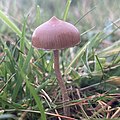Top Qs
Timeline
Chat
Perspective
Psilocybe fimetaria
Species of fungus From Wikipedia, the free encyclopedia
Remove ads
Psilocybe fimetaria is a dung-loving mushroom in the genus Psilocybe. Along with Psilocybe fuscofulva, it is one of two Psilocybe mushroom species that has been found to contain no detectable levels of the psychoactive tryptamines psilocin, psilocybin, or others. In the case of Psilocybe fimetaria, this may be due to some individual specimens having a very low concentration, or the species actually being a pair of morphologically similar species.[2]
This article needs additional citations for verification. (November 2014) |
Remove ads
Etymology
- From the Latin word 'fime', meaning dung, and the standard Latin suffix '-arius', meaning engaged-in or structured.
Description
- Cap: 1.5 — 3.5 cm in diameter, papillate to convex, becoming umbonate to broadly convex in age. Surface even to translucent-striate near the margin, viscid when moist from a thick separable gelatinous pellicle. Often velar remnants on surface, typically around the margin. Pale reddish brown to ochraceous, hygrophanous, fading in drying to yellowish olive to ochraceous buff. Flesh whitish to honey colored.
- Gills: Adnexed, free or sinuate. Close, interleaving and ventricose. Whitish clay at first, eventually dark reddish brown with olivaceous hue, white fimbriate.
- Spore Print: Dark purple-brown, (9.5)12.5 — 15(16) x 6.5 — 9.5 μm, ovoid in front view, ellipsoid in side view, thick walled with a broad germ pore.
- Stipe: 2 – 9 cm long by (0.5)2 – 4 mm thick. Cylindrical, flexuous, equal but sometimes slightly swollen at the base. Whitish at first, soon discolouring yellow to yellowish brown from handling, reddish brown or honey brown in age, sometimes with distinctive blue tones at the base. Surface covered with whitish fibrils towards the apex, with an apical evanescent fibrillose annulus that develops from a thickly cortinate partial veil.
- Odor: Farinaceous
- Taste: Farinaceous
- Microscopic features: Basidia 4-spored. Pleurocystidia absent. Cheilocystidia (15)20 — 30(35) by (4)6 — 8(9) μm, ventricose-fusiform or lageniform with a narrow neck, often flexuous, 4 — 15 by 0.5 — 1.5 μm, occasionally branched.

Remove ads
Habitat and distribution
P. fimetaria is found growing solitary to gregariously on horse or cow dung, in grassy areas, from September to November. Psilocybe semilanceata may be an indicator species for P. fimetaria, as they favour similar grasses, soil types and climatic conditions. It is widely distributed but not very common.
It has been recorded in Great Britain, Iceland and much of mainland Europe. Despite what much of the literature states, there have not been confirmed recordings of P. fimetaria in Asia or the Americas.
Similar species
P. fimetaria is phylogenetically a close relative of Psilocybe liniformans. Not only do they often grow in the same habitat, but they are macroscopically similar. The best way to differentiate the species by testing for the presence of separable gelatinous threads running along the bottom edge of the gills. This feature would indicate P. liniformans.
Deconica coprophila can also appear similar but can be distinguished by its adnate or subdecurrent gill attachment, less-dense gill spacing and its cap being a deeper red colour.
Remove ads
Gallery
- P. fimetaria at various stages of development
- Two P. fimetaria on dung amongst heather
- Single P.fimetaria with sharp papilla
- Two P. fimetaria with Panaeolus papilionaceus behind
- P. fimetaria spores 1000x
References
External links
Wikiwand - on
Seamless Wikipedia browsing. On steroids.
Remove ads






